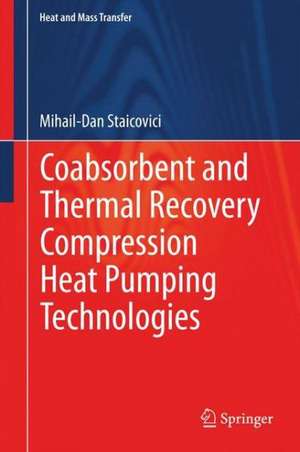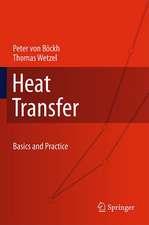Coabsorbent and Thermal Recovery Compression Heat Pumping Technologies: Heat and Mass Transfer
Autor Mihail-Dan Staicovicien Limba Engleză Hardback – 6 mai 2014
Thermal-to-work recovery compression (TWRC) is the first of two particular methods explored here, including how superheat is converted into work, which diminishes the compressor work input. In the second method, thermal-to-thermal recovery compression (TTRC), the superheat is converted into useful cooling and/or heating, and added to the cycle output effect via the coabsorbent technology. These and other methods of discharge gas superheat recovery are analyzed for single-, two-, three-, and multi-stage compression cooling and heating, ammonia and ammonia-water cycles, and the effectiveness results are given.
The author presents absorption-related topics, including the divided-device method for mass and heat transfer analysis, and truncation as a unique method for a better source-task match. Along with advanced gax recovery, the first and second principles of COP and exergy calculation, the ideal point approaching (i.p.a.) effect and the two-point theory of mass and heat transfer, the book also addresses the new wording of the Laplace equation, the Marangoni effect true explanation, and the new mass and heat exchangers based on this effect.
The work goes on to explore coabsorbent separate and combined cooling, heating, and power (CHP) production and advanced water-lithium bromide cycle air-conditioning, as well as analyzing high-efficiency ammonia-water heat-driven heating and industrial low-temperature cooling, in detail.
Readers will learn how coabsorbent technology is based on classic absorption, but is more general. It is capable of offeringeffective solutions for all cooling and heating applications (industry, agriculture, district, household, etc.), provided that two supplying heat-sink sources with temperatures outdistanced by a minimum of 12-15ºC are available. This book has clear and concise presentation and illustrates the theory and applications with diagrams, tables, and flowcharts.
| Toate formatele și edițiile | Preț | Express |
|---|---|---|
| Paperback (1) | 652.31 lei 6-8 săpt. | |
| Springer Berlin, Heidelberg – 3 sep 2016 | 652.31 lei 6-8 săpt. | |
| Hardback (1) | 657.08 lei 6-8 săpt. | |
| Springer Berlin, Heidelberg – 6 mai 2014 | 657.08 lei 6-8 săpt. |
Din seria Heat and Mass Transfer
- 18%
 Preț: 1002.27 lei
Preț: 1002.27 lei - 15%
 Preț: 637.78 lei
Preț: 637.78 lei - 15%
 Preț: 647.92 lei
Preț: 647.92 lei - 15%
 Preț: 579.99 lei
Preț: 579.99 lei - 15%
 Preț: 649.39 lei
Preț: 649.39 lei - 18%
 Preț: 948.79 lei
Preț: 948.79 lei - 18%
 Preț: 990.44 lei
Preț: 990.44 lei - 20%
 Preț: 993.74 lei
Preț: 993.74 lei - 18%
 Preț: 945.30 lei
Preț: 945.30 lei - 18%
 Preț: 887.24 lei
Preț: 887.24 lei - 15%
 Preț: 644.18 lei
Preț: 644.18 lei - 15%
 Preț: 645.28 lei
Preț: 645.28 lei - 18%
 Preț: 1236.19 lei
Preț: 1236.19 lei - 18%
 Preț: 950.96 lei
Preț: 950.96 lei - 18%
 Preț: 947.35 lei
Preț: 947.35 lei - 15%
 Preț: 636.12 lei
Preț: 636.12 lei - 18%
 Preț: 947.85 lei
Preț: 947.85 lei - 15%
 Preț: 639.41 lei
Preț: 639.41 lei - 18%
 Preț: 953.97 lei
Preț: 953.97 lei - 15%
 Preț: 640.88 lei
Preț: 640.88 lei - 18%
 Preț: 957.62 lei
Preț: 957.62 lei - 18%
 Preț: 957.44 lei
Preț: 957.44 lei - 18%
 Preț: 943.25 lei
Preț: 943.25 lei - 18%
 Preț: 1109.29 lei
Preț: 1109.29 lei - 18%
 Preț: 955.70 lei
Preț: 955.70 lei - 15%
 Preț: 642.83 lei
Preț: 642.83 lei - 18%
 Preț: 1214.38 lei
Preț: 1214.38 lei - 15%
 Preț: 649.71 lei
Preț: 649.71 lei - 18%
 Preț: 950.66 lei
Preț: 950.66 lei - 15%
 Preț: 645.47 lei
Preț: 645.47 lei - 18%
 Preț: 1002.13 lei
Preț: 1002.13 lei - 15%
 Preț: 636.12 lei
Preț: 636.12 lei
Preț: 657.08 lei
Preț vechi: 773.03 lei
-15% Nou
Puncte Express: 986
Preț estimativ în valută:
125.73€ • 131.54$ • 104.45£
125.73€ • 131.54$ • 104.45£
Carte tipărită la comandă
Livrare economică 03-17 aprilie
Preluare comenzi: 021 569.72.76
Specificații
ISBN-13: 9783642546839
ISBN-10: 3642546838
Pagini: 540
Ilustrații: XXVI, 501 p. 268 illus., 84 illus. in color.
Dimensiuni: 155 x 235 x 34 mm
Greutate: 0.88 kg
Ediția:2014
Editura: Springer Berlin, Heidelberg
Colecția Springer
Seria Heat and Mass Transfer
Locul publicării:Berlin, Heidelberg, Germany
ISBN-10: 3642546838
Pagini: 540
Ilustrații: XXVI, 501 p. 268 illus., 84 illus. in color.
Dimensiuni: 155 x 235 x 34 mm
Greutate: 0.88 kg
Ediția:2014
Editura: Springer Berlin, Heidelberg
Colecția Springer
Seria Heat and Mass Transfer
Locul publicării:Berlin, Heidelberg, Germany
Public țintă
ResearchCuprins
Introduction.- Mass and Heat Exchange Analysis of the Absorption Processes-The Divided Device Method.- Coabsorbent Cycles.- A Few New Coabsorbent Cycle Configurations.- The Effectiveness of the Coabsorbent Cycles According to the First And Second Principles of Thermodynamics.- External Coabsorbent Cycle Composition.- Coabsorbent Cycles Exergy Evaluation.- A Thermodynamic Approach Of Mechanical Vapor Compression Refrigeration And Heating COP Increase.- A Non-Equilibrium Phenomenological Two-Point Theory Of Mass And Heat Transfer In Physical And Chemical Interactions.- A New Wording Of The Laplace Equation.- Marangoni Convection Basic Mechanism Explanation, Pseudo-Marangoni Cells Model And Absorption-Desorption Mass And Heat Exchangers Model Application.
Textul de pe ultima copertă
This book introduces two of the most exciting heat pumping technologies, the coabsorbent and the thermal recovery (mechanical vapor) compression, characterized by a high potential in primary energy savings and environmental protection. New cycles with potential applications of nontruncated, truncated, hybrid truncated, and multi-effect coabsorbent types are introduced in this work.
Thermal-to-work recovery compression (TWRC) is the first of two particular methods explored here, including how superheat is converted into work, which diminishes the compressor work input. In the second method, thermal-to-thermal recovery compression (TTRC), the superheat is converted into useful cooling and/or heating, and added to the cycle output effect via the coabsorbent technology. These and other methods of discharge gas superheat recovery are analyzed for single-, two-, three-, and multi-stage compression cooling and heating, ammonia and ammonia-water cycles, and the effectiveness results are given.
The author presents absorption-related topics, including the divided-device method for mass and heat transfer analysis, and truncation as a unique method for a better source-task match. Along with advanced gax recovery, the first and second principles of COP and exergy calculation, the ideal point approaching (i.p.a.) effect and the two-point theory of mass and heat transfer, the book also addresses the new wording of the Laplace equation, the Marangoni effect true explanation, and the new mass and heat exchangers based on this effect.
The work goes on to explore coabsorbent separate and combined cooling, heating, and power (CHP) production and advanced water-lithium bromide cycle air-conditioning, as well as analyzing high-efficiency ammonia-water heat-driven heating and industrial low-temperature cooling, in detail.
Readers will learn how coabsorbent technology is based on classic absorption, but is more general. It is capable ofoffering effective solutions for all cooling and heating applications (industry, agriculture, district, household, etc.), provided that two supplying heat-sink sources with temperatures outdistanced by a minimum of 12-15ºC are available.
This book has clear and concise presentation and illustrates the theory and applications with diagrams, tables, and flowcharts.
Thermal-to-work recovery compression (TWRC) is the first of two particular methods explored here, including how superheat is converted into work, which diminishes the compressor work input. In the second method, thermal-to-thermal recovery compression (TTRC), the superheat is converted into useful cooling and/or heating, and added to the cycle output effect via the coabsorbent technology. These and other methods of discharge gas superheat recovery are analyzed for single-, two-, three-, and multi-stage compression cooling and heating, ammonia and ammonia-water cycles, and the effectiveness results are given.
The author presents absorption-related topics, including the divided-device method for mass and heat transfer analysis, and truncation as a unique method for a better source-task match. Along with advanced gax recovery, the first and second principles of COP and exergy calculation, the ideal point approaching (i.p.a.) effect and the two-point theory of mass and heat transfer, the book also addresses the new wording of the Laplace equation, the Marangoni effect true explanation, and the new mass and heat exchangers based on this effect.
The work goes on to explore coabsorbent separate and combined cooling, heating, and power (CHP) production and advanced water-lithium bromide cycle air-conditioning, as well as analyzing high-efficiency ammonia-water heat-driven heating and industrial low-temperature cooling, in detail.
Readers will learn how coabsorbent technology is based on classic absorption, but is more general. It is capable ofoffering effective solutions for all cooling and heating applications (industry, agriculture, district, household, etc.), provided that two supplying heat-sink sources with temperatures outdistanced by a minimum of 12-15ºC are available.
This book has clear and concise presentation and illustrates the theory and applications with diagrams, tables, and flowcharts.
Caracteristici
Presents theory and practical aspects for applications Offers new opportunities for heat pumping and power production Includes many illustrations tables and diagrams supporting the understanding Includes supplementary material: sn.pub/extras











